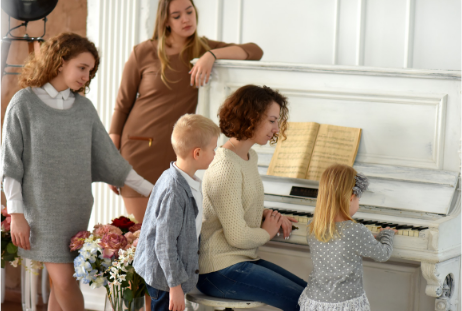facebooktwitterpinterestinstagramyoutubeLearning to play the piano or any instrument for that matter sounds like fun, but can be a daunting task. One of the reasons many kids drop out from learning piano, is that it is not all fun and games. So it is important to...

3 ‘Must Know’ Methods To Teach Kids To Identify D4 And G5 On The Piano Keyboard
3 ‘Must Know’ Methods To Teach Kids To Identify D4 And G5 On The Piano Keyboard
See below for a Free Printable Pack to go with the post.
If you’ve taught your kids to read music notes and play the piano, you will know that the notes D4 and G5 are neither line nor space notes.
While both these notes are important notes to know, since they don’t fall into either category it is hard to know when to introduce kids to these notes.
In this post I will discuss three methods to introduce kids to the notes.
You can choose either one of the three methods.
Yes, I am partial to one of the methods over the other, but that doesn’t mean that my favourite method is better than the other two methods I have explained here.
So, please read through the post and decide, which method you would like to try when teaching your kids to read music notes and play the piano in your homeschool.
Don’t forget to download the music theory worksheet I have included to help reinforce the concept of D4 and G5 to your kids.
So, if you are ready, we can get started right now.
Method 1 – Stand Alone
Like its name, this method is ‘stand alone’, meaning you should teach both notes ‘Dangerous D’ (D4) and ‘Giggling G’ (G5) after teaching your child the Treble Line and Space notes.
With this method you will:
– First show your child the flashcard for D4
– Explain that it is D4 and called ‘Dangerous D’ because it hangs from the Treble Staff.
– Ask your child to show D4 on the keyboard.
– You will follow the same steps and introduce G5 as well.
Method 2 – Teach, when introducing Middle C
You can introduce both ‘Dangerous D’ and ‘Giggling G’ to your child, when teaching them Middle C.
With this method you will:
– First show Middle C and point to D4 and G5 in relation to Middle C. – Show flashcards and say D4 is called ‘Dangerous D’ because the note hangs from the Treble Staff and G5 is called ‘Giggling G’ because the note sits on the Treble Staff.
Method 3 – Introduce D4 with Treble Clef Line Notes and G5 with Treble Clef Space Notes
This is by far my favourite method. However, please remember that methods 1 and 2 are equally good.
With this method you will:
– Teach the Treble Clef line notes and introduce them to D4, by showing them the flashcard, telling them that it is called ‘Dangerous D’ because it hangs from the Treble Staff and then show them the note on the keyboard.
– Teach the Treble Clef space notes and introduce them to G5, by showing them the flashcard, telling them that it is called ‘Giggling G’ because it sits on the Treble Staff and then showing them the note on the keyboard.
Would you like to implement Method 2 but still haven’t introduced your kids to Middle C? Then read my post 3 Absolutely Important Facts To Know About Middle C.
Want to use Method 3? In that case, you will have to first read and implement 5 ‘Incredibly Easy’ Steps To Teach Treble Clef Line Notes, and 5 ‘Ridiculously Easy’ Steps To Teach Treble Clef Space Notes.
Either way don’t forget to download the music theory worksheet I have made available with this post.
What is your favourite method?
Comment below and let me know.

Karen Cadera
Founder/Creator
Mom, Teacher, Minimalist, Zero Waste Enthusiast, Multi Pod.
My daughter loved the games, but there were also worksheets and videos. The weekly lesson plans were complete, and I never questioned what I should be doing next.
Download the FREE Music Theory Worksheet
Articles That Maybe Of Interest To You
5 Awesome Life Lessons Your Child Will Acquire When Learning To Play The Piano In The Homeschool
6 ‘Amazing Games’ To Play When Introducing Whole/Half/Quarter & Eighth Notes & Rests To Kids
facebooktwitterpinterestinstagramyoutubeSee below for a Free Printable Pack to go with the post.When you are teaching notes and rests to kids in quick succession, it can be confusing. The easiest way to mitigate this problem is to play different games to reinforce...
9 Thing Your One On One Music Teacher Will Not Tell You
facebooktwitterpinterestinstagramyoutubeEven today in the era of online learning I still find parents who insist that nothing can take the place of one on one piano lessons. While this is true, it is not absolutely true. This I would have to say is the GREAT one on...













